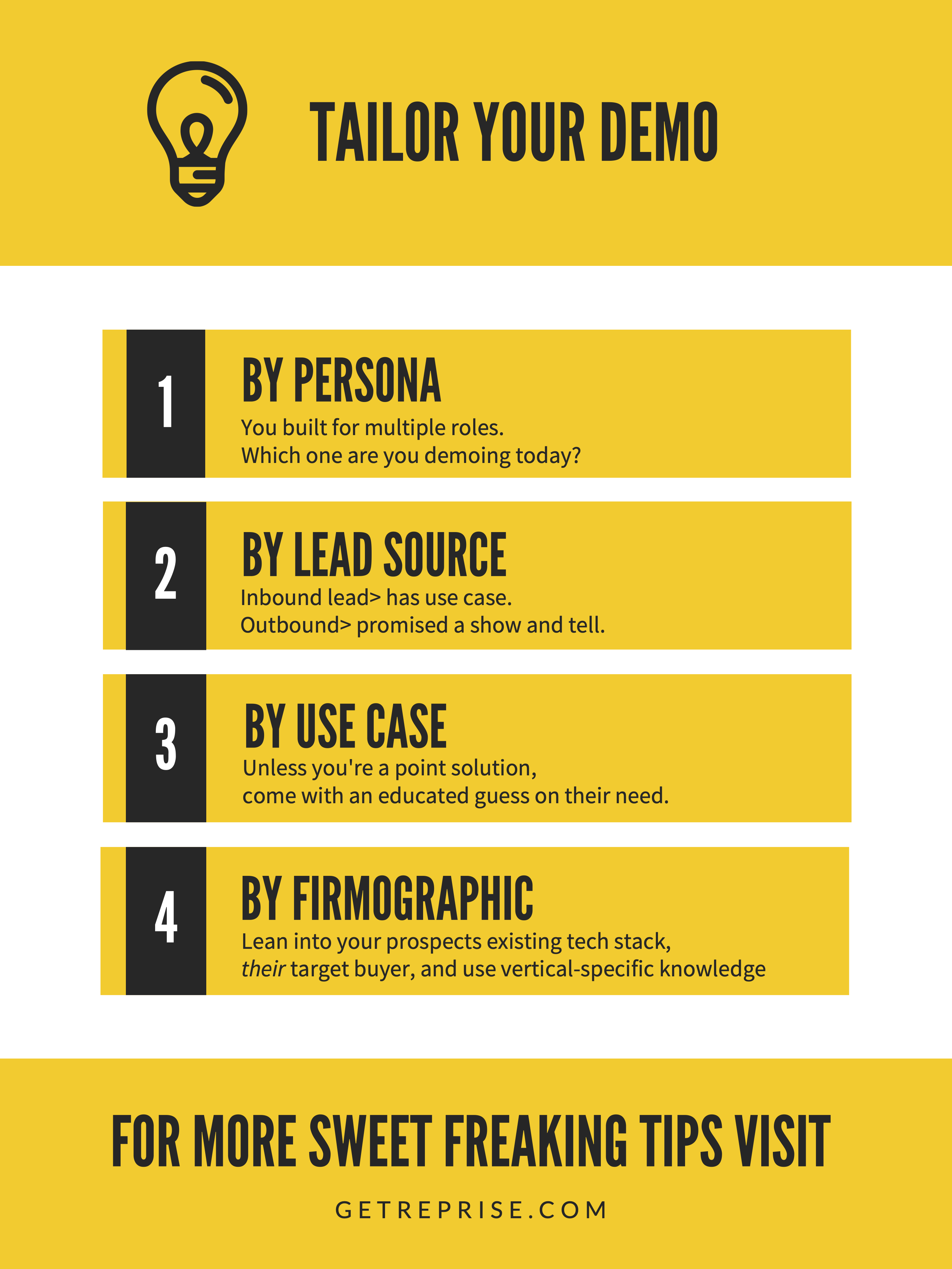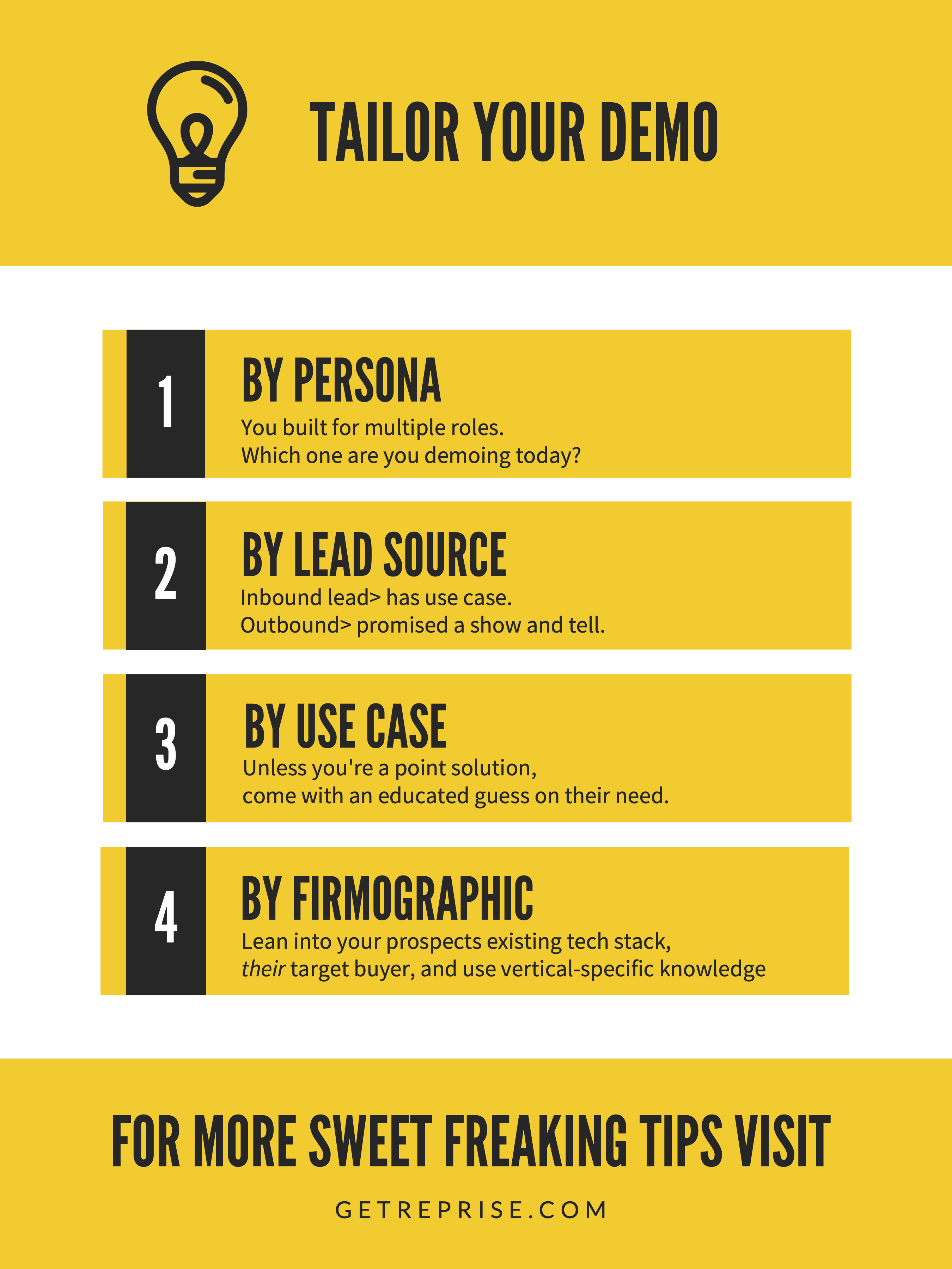Accelerate deals and increase win rates with the leading enterprise AI demo platform.
How to Create a Tailored Product Demo

April 22, 2025
Table of Contents
There’s a problem in SaaS sales right now. We’ve talked about it before – your buyers want a demo right away, on the first call, and you aren’t giving it to them.
But that’s not because you want to turn your process into a fist fight. You do have good reasons for pushing that discovery call before you get to the demo the buyer wants.
As a happy middle ground, sales teams are adopting a hybrid discovery/demo approach to the first call. Or, they’re offering a ‘business value’ demo on the first call (an overview), in exchange for discovery and then a full demo on the next call. Another approach we’re seeing is to demo “case studies” or “a day in the life” use cases of your product to test which value prop resonates with your prospect. It’s hard though…
How do you know “which pitch” to give if you haven’t done discovery??!
If you jump right into a demo with no background info, you’re giving a pitch without getting the info you need to make it effective. It’s a known fact that tailoring/personalizing is necessary throughout the entire sales funnel. So, if you’re offering a demo right away with no idea who this buyer is or what they want, you’re at risk of delivering a pitch that doesn’t resonate.
So how can you give the buyer what they want – the demo – while getting enough info to actually make it effective? How can you make pitching on the first call work?
Here it is, you big dummy: By tailoring your demo based on information that is readily available to you.
How to Get the Info You Need to Tailor Your Demo
From a roundtable with the top minds in SaaS sales comes the top four ways to tailor your demo without a full discovery call. These four ways to customize your demo come from their years of experience in the SaaS sales world. They’ll help you provide a custom demo that provides real value for your prospects, without playing keepaway with the demo your website marketing promises. So step right up and drink in their righteous glory.
By Persona
You created this tool to serve people in multiple roles. But you’re only showing this demo to one person. Which role are you pitching to today? You know every SaaS purchase is buying by committee – you’re going to have to win over multiple roles to make the sale. But the first step is pitching to this one person, today.
LinkedIn is a great source for the most essential info – title, background, and if you’re lucky, maybe some posts about their role and their goals. Think back to the last positive interaction you’ve had with other people in this role – what worked? What drives them? The idea here isn’t to show off all your bells and whistles – it’s to nail the most direct line to the heart of the person sitting right in front of you. Help them.
By Lead Source
Meetings come from different places – did they come inbound on your site, have they bought you twice before, or are you jumping on an outbound BDR’s 4PM meeting with no notice on the last day of a month? Your lead source dictates the expectations your prospect will have for the meeting. If they’re inbound, it’s only natural you should ask what compelled them. What a great start to a conversation.
But if you hooked them with some sort of promise (literally a demo, or some vague promise of ‘come see’ something), then you’d better be ready to shape more of the conversation. That means, you talk. Long story short – tailor your approach to the first call based on where the call came from.
By Use Case
It might be product line, or SKU, or vertical, or role (again), or some other factor. But most of us have a few different ‘use cases’ or value props for our various segments. But we rehearsed this all-encompassing pitch that crosses them all. “Hey, check out this Dr. Seuss-looking all-in-one sales Swiss army knife – it can send your emails, update your forecast, and uses AI to become the Uber of Sendoso!”
Cut it out. Nobody wants to sit through random features and wait for you to cover “all the value” your “full suite” provides. Nail a short, 3-5 minute walkthrough of the most important feature set in a “day in the life” story that has a very direct narrative on how you accomplish that single most important use case. Only pitch one – don’t get sucked into your full set.
By Firmographic
Help your prospect picture themself using your product in their daily workflow. As one of our roundtable experts told me, “people will look for themselves in the demo that you’re giving.” So, don’t make stupid mistakes that throw them off. Only quote customer stories from their segment. Make sure to tell use case stories for their specific job function. Stop using SMB language on Enterprise pitches. Stop delivering right-brain value props to left-brain personas.
You resonate in the first five minutes, or you don’t. So the free dialogue opens up from there, or it doesn’t. Take what you can easily find online about the prospect’s business and make sure you’re acting as if that’s the only circle you run in.
Make Pitching on the First Call Work
When your website and marketing materials are covered in “Try It Now!” buttons, your buyers are going to expect you to come with it. They don’t want to sit through an awkward and frustrating discovery call just to “earn” the right to see the product next time. They just want to know what it does and how it works.
But they still expect to see how it would work for them – not a generic one-size-fits-all bulldozer.







